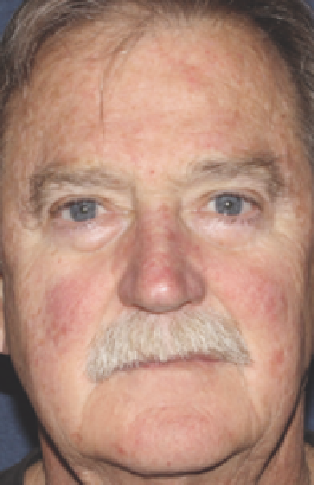Biomedical Engineering Reference
In-Depth Information
(
A
)
(
B
)
(
C
)
Figure 10.7
Here we can see greatest improvement with the fi rst two aminolevulinic acid-photodynamic therapy sessions (
A,B
) as the patient presented more
photodamage, but further improvement is achieved in vascularity, pigmentation, and skin sallowness after one additional session (
C
).
(
A
)
(
B
)
Figure 10.8
(
A
) White male with moderate erythema and telangiectasias concentrated over the nose on a background of mild-to-moderate photodamage. The
patient had received a single treatment of intense pulsed light without signifi cant clearance. (
B
). Signifi cant improvement after one treatment of aminolevulinic
acid-photodynamic therapy.
combined use of ALA-IPL for the treatment of photorejuvena-
tion with one treatment session. Sixty-nine percent of the AKs
responded to the use of ALA-IPL. Additionally, a 55% improve-
ment in telangiectasias, 48% improvement in pigment irregu-
larities, and 25% improvement in skin texture were observed.
Alster and colleagues (179) also examined the use of IPL in
ALA-PDT. Ten patients with mild-to-moderate photodamage
underwent two sessions of split-face treatment. Patients
received treatment with ALA-IPL on one side and IPL alone
on the contralateral side at 4-week intervals. Clinical improve-
ment scores were noted to be higher on the side of the
face treated with the combination of ALA-IPL. They con-
cluded that the combination of topical-ALA + IPL is safe
and more effective than IPL alone for the treatment of facial
rejuvenation.
Another split-face study on ALA-IPL versus IPL alone was
performed by Dover et al. (167). In this study, 20 subjects had
three split-face treatments 3 weeks apart. Half of the face was
treated with ALA followed by IPL treatment and the other half
was treated with IPL alone. A blinded investigator was used to
evaluate global photodamage, fi ne lines, mottled pigmenta-
tion, tactile roughness, and sallowness during the study. They
concluded that pretreatment with ALA followed by IPL
resulted in greater improvement in global photoaging (80% vs.
50%) and mottled pigmentation (95% vs. 65%). Successful
results were also noted for fi ne lines for the ALA-IPL side com-
pared with the IPL side alone (55% vs. 20%). Although tactile
roughness and sallowness were noticeably better, pretreatment
with ALA did not enhance the results of using IPL alone. It was
important to note that both modes of treatment were well






















